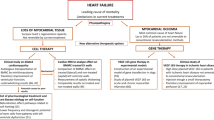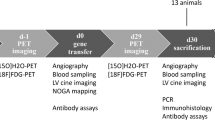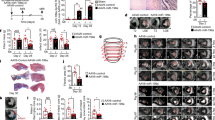Abstract
Increased coronary blood vessel development could potentially benefit patients with ischemic heart disease. In a model of stress–induced myocardial ischemia, intracoronary injection of a recombinant adenovirus expressing human fibroblast growth factor–5 (FCF–5) resulted in messenger RNA and protein expression of the transferred gene. Two weeks after gene transfer, regional abnormalities in stress–induced function and blood flow were improved, effects that persisted for 12 weeks. Improved blood flow and function were associated with evidence of angiogenesis. This report documents, for the first time, successful amelioration of abnormalities in myocardial blood flow and function following in vivo gene transfer.
This is a preview of subscription content, access via your institution
Access options
Subscribe to this journal
Receive 12 print issues and online access
$209.00 per year
only $17.42 per issue
Buy this article
- Purchase on Springer Link
- Instant access to full article PDF
Prices may be subject to local taxes which are calculated during checkout
Similar content being viewed by others
References
Benharroch, D. & Birnbaum, D. Biology of the fibroblast growth factor gene family. Israeli J. Med. Sciences 26, 212–219 (1990).
Goldfarb, M., Bates, B., Drucker, B., Hardin, J. & Haub, O. Expression and possible functions of the FGF-5 gene. Ann. NY Acad. Sci. 638, 38–52 (1991).
Folkman, J. & Shing, Y., J. Biol. Chem. 267, 10931–10934 (1992).
Thompson, J.A. et al. Heparin-binding growth factor 1 induces the formation of organoid neovascular structures in vivo. Proc. Natl. Acad. Sci. USA 86, 7928–7932 (1989).
Morrow, N.G., Kraus, W.E., Moore, J.W., Williams, R.S. & Swain, J.L. Increased expression of fibroblast growth factors in a rabbit skeletal muscle model of exercise conditioning. J. Clin. Invest. 85, 1816–1820 (1990).
Yanagisawa-Miwa, A. et al. Salvage of infarcted myocardium by angiogenic action of basic fibroblast growth factor. Science 257, 1401–1403 (1992).
Harada, K. et al. Basic fibroblast growth factor improves myocardial function in chronically ischemic porcine hearts. J. Clin. Invest. 94, 623–630 (1994).
Unger, E.F. et al. Basic fibroblast growth factor enhances myocardial collateral flow in a canine model. Am. J. Physiol. 266, H1588–H1595 (1994).
Banai, S. et al. Angiogenic-induced enhancement of collateral blood flow to ischemic myocardium by vascular endothelial growth factor in dogs. Circulation 89, 2183–2189 (1994).
Stratford-Perricaudet, L.D., Makeh, I., Perricaudet, M. & Briand, P. Widespread long-term gene transfer to mouse skeletal muscles and heart. J. Clin. Invest. 90, 626–630 (1992).
Barr, E. et al. Gene transfer into the heart using replication-defective adenovirus. Gene Ther. 1, 51–58 (1994).
Ohno, T. et al. Gene therapy for vascular smooth muscle cell proliferation after arterial injury. Science 265, 781–784 (1994).
Guzman, R.J., Lemarchand, P., Crystal, R.G., Epstein, S.E. & Finkel, T. Efficient gene transfer into myocardium by direct injection of adenovirus vectors. Circ. Res. 73, 1202–1207 (1993).
Kass-Eisler, K. et al. Quantitative determination of adenovirus-mediated gene delivery to rat cardiac myocytes in vitro and in vivo. Proc. Natl. Acad. Sci. USA 90, 11498–11502 (1993).
McGrory, W.J., Bautista, D.S. & Graham, F.L. A simple technique for the rescue of early region I mutations into infectious human adenovirus type 5. Virology 163, 614–617 (1988).
White, F.C., Carroll, S.M., Magnet, A. & Bloor, C.M. Coronary collateral development in swine after coronary artery occlusion. Circ. Res. 71, 1490–1500 (1992).
Roth, D.M. et al. Development of coronary collateral circulation in left circumflex Ameroid-occluded swine myocardium. Am. J. Physiol. 253, H1279–H1288 (1987).
Roth, D.M. et al. Effect of long-term exercise on regional myocardial function and coronary collateral development after gradual coronary artery occlusion in pigs. Circulation 82, 1778–1789 (1990).
Hammond, H.K. & McKirnan, M.D. The effects of dobutamine and arbutamine on regional myocardial function in a porcine model of myocardial ischemia. J. Am. Coll. Cardiol. 23, 475–482 (1994).
Hammond, H.K., Roth, D.A., McKirnan, M.D. & Ping, P. Regional myocardial down-regulation of the inhibitory GTP-binding protein (Giα2) and β-adrenergic receptors in a porcine model for chronic episodic ischemia. J. Clin. Invest. 92, 2644–2652 (1993).
Goto, F., Goto, K., Weindel, K. & Folkman, J. Synergistic effects of vascular endothelial growth factor and basic fibroblast growth factor on the proliferation and cord formation of bovine capillary endothelial cells within collagen gels. Lab. Invest. 69, 508–517 (1993).
Bernotat-Danielowski, S., Sharma, H.S., Schott, R.J. & Schaper, W. Generation and localisation of monoclonal antibodies against fibroblast growth factors in ischaemic collateralised porcine myocardium. Cardiovasc. Res. 27, 1220–1228 (1993).
Casscells, W. et al. Isolation, characterization, and localization of heparin binding growth factors in the heart. J. Clin. Invest. 85, 433–441 (1990).
Nienaber, C.A., Salge, D., Spielmann, R.P., Montz, R. & Bleifeld, W. Detection of human collateral circulation by vasodilation-thallium-201 tomography. Am. J. Cardiol. 65, 991–998 (1990).
Yang, Y. et al. Cellular immunity to viral antigens limits E1-deleted adenoviruses for gene therapy. Proc. Natl. Acad. Sci. USA 91, 4407–4411 (1994).
French, B.A., Mazur, W., Geske, R.S. & Bolli, R. Direct in vivo gene transfer into porcine myocardium using replication-deficient adenoviral vectors. Circulation 90, 2414–2424 (1994).
Moullier, P. et al. Adenoviral-mediated gene transfer to renal tubular cells in vivo. Kidney Int. 45, 1220–1225 (1994).
Sahn, D.J., DeMaria, A.N., Kisslo, J. & Weyman, A. Recommendations regarding quantitation in M-mode echocardiography: Results of a survey of echocardiographic measurements. Circulation 58, 1072–1083 (1978).
Skyba, D.M. et al. Quantification of myocardial perfusion with myocardial contrast echocardiography during left atrial injection of contrast: Implications for venous injection. Circulation 90, 1513–1521 (1994).
Kajstura, J. et al. Myocyte cellular hyperplasia and myocyte cellular hypertrophy contribute to chronic ventricular remodeling in coronary artery narrowing-induced cardiomyopathy in rats. Circ. Res. 74, 383–400 (1994).
Mathieu-Costello, O. Capillary tortuosity and degree of contraction or extension of skeletal muscles. Microvasc. Res. 33, 98–117 (1987).
Poole, D.C. & Mathieu-Costello, O. Analysis of capillary geometry in rat subepicardium and subendocardium. Am. J. Physiol. 259, H204–H210 (1990).
Kitaoka, T., Aotaki-Keen, A.E. & Hjelmeland, L.M. Distribution of FGF-5 in the rhesus macaque retina. Invest. Ophthalmol. Vis. Sci. 35, 3189–3198 (1994).
Roth, D.A., Urasawa, K., Helmer, G.A. & Hammond, H.K. Down-regulation of cardiac GTP-binding proteins in right atrium and left ventricle in pacing-induced congestive heart failure. J. Clin. Invest. 91, 939–949 (1993).
Ping, P. & Hammond, H.K. Diverse G protein and β-adrenergic receptor mRNA expression in normal and failing porcine hearts. Am. J. Physiol. 267, H2079–H2085 (1994).
Tsai, P.S., Werner, S. & Weiner, R.I. Basic fibroblast growth factor is a neurotropic factor in GT1 gonadotropin-releasing hormone neuronal cell lines. Endocrinology 136, 3831–3838 (1995).
Author information
Authors and Affiliations
Rights and permissions
About this article
Cite this article
Giordano, F., Ping, P., McKirnan, M. et al. Intracoronary gene transfer of fibroblast growth factor–5 increases blood flow and contractile function in an ischemic region of the heart. Nat Med 2, 534–539 (1996). https://doi.org/10.1038/nm0596-534
Received:
Accepted:
Issue Date:
DOI: https://doi.org/10.1038/nm0596-534
This article is cited by
-
Universal redirection of CAR T cells against solid tumours via membrane-inserted ligands for the CAR
Nature Biomedical Engineering (2023)
-
The Role of Angiogenesis and Arteriogenesis in Myocardial Infarction and Coronary Revascularization
Journal of Cardiovascular Translational Research (2022)
-
Effect of captopril on post-infarction remodelling visualized by light sheet microscopy and echocardiography
Scientific Reports (2021)
-
Multi-gene signature of microcalcification and risk prediction among Taiwanese breast cancer
Scientific Reports (2020)
-
Genomic signatures of high-altitude adaptation in Ethiopian sheep populations
Genes & Genomics (2019)



